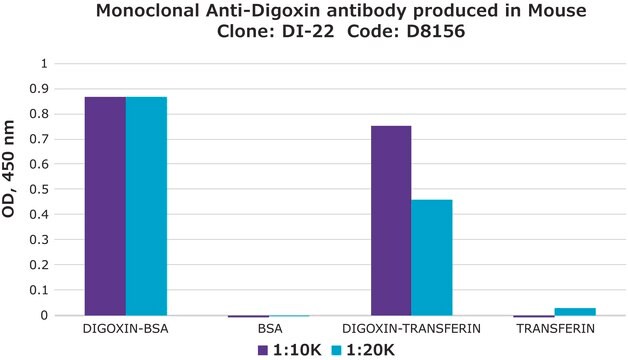D9026
Digoxigenin
analytical standard
Synonym(e):
3β,12β,14β,21-Tetrahydroxy-20,(22)-norcholensäure-lacton, 3β,12β,14-Trihydroxy-5β,20(22)-cardenolid, 5β,20(22)-Cardenolid-3β,12β,14-triol, Lanadigigenin
About This Item
Empfohlene Produkte
Qualität
analytical standard
Qualitätsniveau
Agentur
EPA 1694
Assay
≥98% (HPLC)
Methode(n)
HPLC: suitable
gas chromatography (GC): suitable
mp (Schmelzpunkt)
222 °C (lit.)
Anwendung(en)
environmental
food and beverages
forensics and toxicology
veterinary
Format
neat
Funktionelle Gruppe
ketone
Lagertemp.
room temp
SMILES String
C[C@]12CC[C@H](O)C[C@H]1CC[C@@H]3[C@@H]2C[C@@H](O)[C@]4(C)[C@H](CC[C@]34O)C5=CC(=O)OC5
InChI
1S/C23H34O5/c1-21-7-5-15(24)10-14(21)3-4-17-18(21)11-19(25)22(2)16(6-8-23(17,22)27)13-9-20(26)28-12-13/h9,14-19,24-25,27H,3-8,10-12H2,1-2H3/t14-,15+,16-,17-,18+,19-,21+,22+,23+/m1/s1
InChIKey
SHIBSTMRCDJXLN-KCZCNTNESA-N
Suchen Sie nach ähnlichen Produkten? Aufrufen Leitfaden zum Produktvergleich
Allgemeine Beschreibung
Anwendung
Signalwort
Danger
H-Sätze
Gefahreneinstufungen
Acute Tox. 1 Inhalation - Acute Tox. 1 Oral - Acute Tox. 2 Dermal
Lagerklassenschlüssel
6.1A - Combustible acute toxic Cat. 1 and 2 / very toxic hazardous materials
WGK
WGK 3
Hier finden Sie alle aktuellen Versionen:
Besitzen Sie dieses Produkt bereits?
In der Dokumentenbibliothek finden Sie die Dokumentation zu den Produkten, die Sie kürzlich erworben haben.
Kunden haben sich ebenfalls angesehen
Unser Team von Wissenschaftlern verfügt über Erfahrung in allen Forschungsbereichen einschließlich Life Science, Materialwissenschaften, chemischer Synthese, Chromatographie, Analytik und vielen mehr..
Setzen Sie sich mit dem technischen Dienst in Verbindung.









